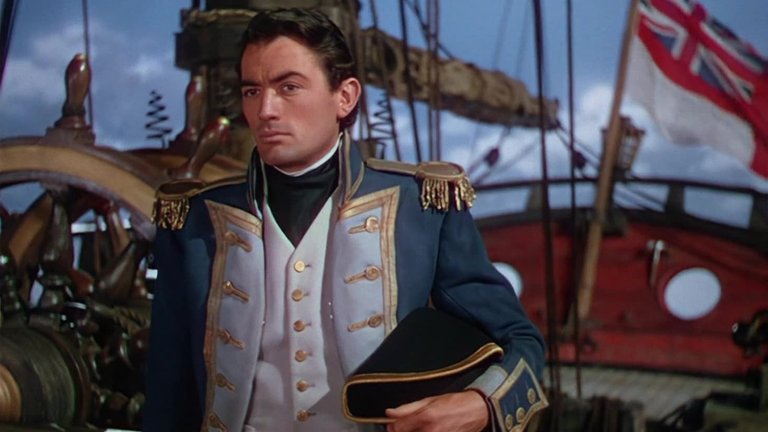Film Review: Captain Horatio Hornblower (1951)

French Revolutionary and Napoleonic Wars represent period that could, in terms of long term political consequences and influence on popular culture, be matched only by Second World War. The latter can be attributed to its great length, plenty of exotic locations, truly global scale, soap opera-like twists in political alignments, exotic costumes and opportunity for old school swashbuckling action. All those qualities are present in Captain Horatio Hornblower, 1951 period adventure film directed by Raoul Walsh, which is considered one of the most successful works of the genre.
The film is based on the popular series of novels by British author C. S. Forester about Royal Navy officer Horatio Hornblower. The plot begins in 1807 when Hornblower (played by Gregory Peck) is given command of 38-gun frigate HMS Lydia and sent to Central America to conduct top secret mission. At the time, Spain is allied to Napoleonic France, and the British, in hope of diverting Spanish resources from Europe, try to support rebellion started by local warlord Don Juan Alvarado a.k.a. El Supremo (played by Alec Mango). Hornblower brings weapons and ammunition to El Supremo and, later, a much larger Spanish 60-gun ship Natividad, which he took in daring nighttime raid. Upon return, he intercepts small Spanish boat and receives information that Spain, due to Napoleon’s invasion, switched sides. Lady Barbara Wellesley (played by Virginia Mayo), sister of Duke of Wellington who had been previously captured by Spanish, is to be repatriated back to England. Hornblower first has to defeat Natividad again, and after he does it, he starts long voyage back home. He falls in love in Lady Barbara, but learns that she is engaged to Rear Admiral Sir Rodney Leighton (played by Denis O’Dea), who will soon become his superior officer and take part in blockade of French coast.
Captain Horatio Hornblower was directed by Raoul Walsh, who had been among the Hollywood’s oldest and the most experienced directors at the time. Most of Walsh films were action-oriented, and two - They Died with Their Boots On and Objective, Burma! - starred Errol Flynn, an actor who had built his stardom playing dashing swashbuckling hero of pirate films. Flynn was actually supposed to play title character, but his advanced age, health issues and increasingly combative stance towards Warner Bros. led the studio to contemplate replacement in form of Burt Lancaster, former acrobat who, however, apparently lacked ability to convincingly play British officer. There weren’t any such issues for Gregory Peck, an actor who compensated relative lack of physical skills with his height and charisma. Virginia Mayo, brought to provide eye candy for male audience and romantic subplot, is, however, less convincing as Anglo-Irish aristocrat. But the rest of the cast, which includes some future stars like Stanley Baker or Christopher Lee in minor roles, is more than solid. Walsh had large budget at his disposal and showed it through many scenes of spectacular naval combat, many of which used simple but effective optical tricks and even authentic ships from the Age of Sail, including HMS Victory, celebrated ship of Admiral Nelson. This is complemented by effective Technicolor cinematography by Guy Greeen and use of locations in Britain, France and Mediterranean that make Captain Horatio Hornblower one of the more visually appealing films of its time.
Like with many visually appealing films, it is the actual content that leaves something to be desired, and Walsh’s film isn’t an exception. The script, co-written by Forester himself, was based on three different novels and it is partially reflected in its episodic structure and three segments that actually don’t have much to do with each other – Hornblower’s mission in Central America, long journey home and dashing raid on the French coast followed by even more daring escape. However, even with those flaws script for Captain Horatio Hornblower should be praised for its generally realistic approach to the period, most notably in depicting how naval warfare two centuries ago, before advent of radio, involved situations in which someone could take dangerous missions half a world and fight enemy only to later discover that the enemy had turned into ally. Even the complexities of Napoleonic Europe, which Dutch as reluctant allies of France, are taken into consideration and used as part of the plot. That makes Captain Horatio Hornblower not only much more entertaining, but more historically accurate than Master and Commander, which covered the same themes and setting half a century later. Hornblower novels were again adapted to screen roughly at the same time, as a series of eight television films starring Ioan Gruffud aired between 1998 and 2003.
RATING: 7/10 (+++)
Blog in Croatian https://draxblog.com
Blog in English https://draxreview.wordpress.com/
InLeo blog https://inleo.io/@drax.leo
InLeo: https://inleo.io/signup?referral=drax.leo
Unstoppable Domains: https://unstoppabledomains.com/?ref=3fc23fRc42c1b417
Hiveonboard: https://hiveonboard.com?ref=drax y
Bitcoin Lightning HIVE donations: https://v4v.app/v1/lnurlp/qrcode/drax
Rising Star game: https://www.risingstargame.com?referrer=drax
1Inch: https://1inch.exchange/#/r/0x83823d8CCB74F828148258BB4457642124b1328e
BTC donations: 1EWxiMiP6iiG9rger3NuUSd6HByaxQWafG
ETH donations: 0xB305F144323b99e6f8b1d66f5D7DE78B498C32A7
Posted using CineTV